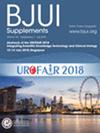开放、腹腔镜和机器人单纯性前列腺切除术的围手术期疗效。
IF 4.4
2区 医学
Q1 UROLOGY & NEPHROLOGY
引用次数: 0
摘要
目的比较开放(OSP)、腹腔镜(LSP)和机器人辅助的单纯前列腺切除术(RASP)的围手术期结局和趋势。材料和方法我们使用由联邦统计局研究数据中心提供的德国全国住院患者数据(GRAND),并进行了多项患者水平的分析。结果2013年至2023年,德国因无膀胱结石的良性前列腺增生患者行单纯前列腺切除术46 234例。其中,44194例(96%)采用开放式手术,724例(1%)采用腹腔镜手术,1335例(3%)采用机器人手术。在接受OSP的患者中,11755例(27%)采用经囊入路,32439例(73%)采用经膀胱入路。我们比较了经囊OSP与RASP和LSP。在研究期间,RASP的使用率呈指数增长,OSP的使用率逐渐下降,LSP的使用率保持稳定。在多变量回归分析中,与OSP(13%)相比,LSP(6.5%,优势比[OR] 0.46, 95%可信区间[CI] 0.34-0.62, P < 0.001)和RASP (7.3%, OR 0.58, 95% CI 0.47-0.72, P < 0.001)的住院输血量更低。与OSP(9.3%)相比,LSP (4.6%; OR 0.46, 95% CI 0.32-0.65, P < 0.001)和RASP (6.4%; OR 0.68, 95% CI 0.54-0.85, P < 0.001)后住院尿潴留发生率显著降低。住院时间中位数(四分位数间距)OSP为9(8-12)天,RASP为7(6-9)天(P < 0.001), LSP为4(4-7)天(P < 0.001)。与经膀胱OSP相比,经囊OSP与更低的重症监护病房入院风险(P < 0.001)和更短的住院时间(P < 0.001)相关。结论与OSP相比,RASP生长迅速,围手术期预后较好。本文章由计算机程序翻译,如有差异,请以英文原文为准。
Peri-operative outcomes of open, laparoscopic and robotic simple prostatectomy.
OBJECTIVE
To compare peri-operative outcomes and trends in open (OSP), laparoscopic (LSP) and robot-assisted simple prostatectomy (RASP).
MATERIALS AND METHODS
We used German Nationwide Inpatient Data (GRAND), provided by the Research Data Centre of the Federal Bureau of Statistics, and performed multiple patient-level analyses.
RESULTS
Between 2013 and 2023, 46 234 simple prostatectomies were performed in Germany for benign prostatic hyperplasia without concomitant bladder stones. Of these, 44 194 (96%) were performed with an open, 724 (1%) with a laparoscopic, and 1335 (3%) with a robotic approach. Among patients undergoing OSP, 11 755 (27%) cases were performed with a transcapsular and 32 439 (73%) with a transvesical approach. We compared transcapsular OSP vs RASP and LSP. The adoption of RASP increased exponentially during the period studied, while the use of OSP gradually declined, and that of LSP remained stable. In multivariable regression analyses, in-hospital transfusions were lower for LSP (6.5%; odds ratio [OR] 0.46, 95% confidence interval [CI] 0.34-0.62, P < 0.001) and RASP (7.3%; OR 0.58, 95% CI 0.47-0.72, P < 0.001) compared to OSP (13%). In-hospital urinary retention was significantly less frequent after LSP (4.6%; OR 0.46, 95% CI 0.32-0.65, P < 0.001) and RASP (6.4%; OR 0.68, 95% CI 0.54-0.85, P < 0.001) compared to OSP (9.3%). The median (interquartile range) hospital stay was 9 (8-12) days for OSP, 7 (6-9) days for RASP (P < 0.001) and 4 (4-7) days for LSP (P < 0.001). Transcapsular OSP was associated with a lower risk of intensive care unit admission (P < 0.001) and shorter hospital stay (P < 0.001) compared to transvesical OSP.
CONCLUSION
Our results showed that RASP is rapidly growing and offers better peri-operative outcomes compared to OSP.
求助全文
通过发布文献求助,成功后即可免费获取论文全文。
去求助
来源期刊

BJU International
医学-泌尿学与肾脏学
CiteScore
9.10
自引率
4.40%
发文量
262
审稿时长
1 months
期刊介绍:
BJUI is one of the most highly respected medical journals in the world, with a truly international range of published papers and appeal. Every issue gives invaluable practical information in the form of original articles, reviews, comments, surgical education articles, and translational science articles in the field of urology. BJUI employs topical sections, and is in full colour, making it easier to browse or search for something specific.
 求助内容:
求助内容: 应助结果提醒方式:
应助结果提醒方式:


